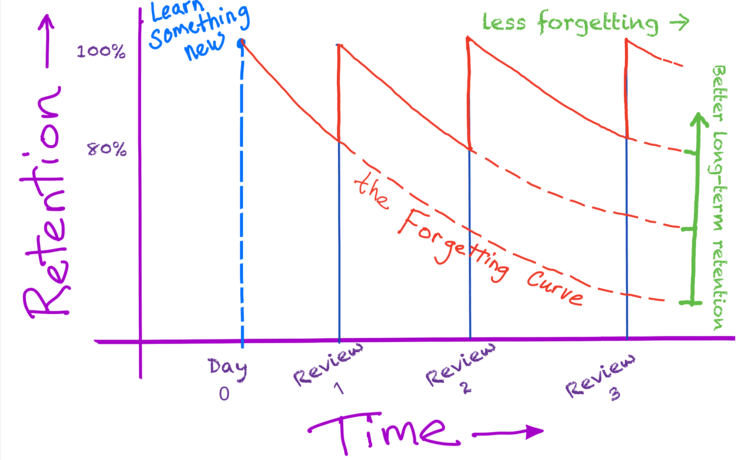
Spaced learning is your antidote!
Throughout high school and for part of college, I was a “cramming enthusiast.” Does that describe you or a student in your life? I crammed because cramming seemed to work (and I wasn’t the best at planning ahead).
But there are three main problems with cramming:
- takes even longer than spaced learning
- leads to short-term learning
- cramming (especially the night before) means less sleep (necessary for your mental and physical health!)
Spaced learning is an evidenced-based memory technique that includes a combination of repetition, breaks, and physical distractors to retain information. It has long been recognized as one of the most effective ways to learn and leads to long-term retention.
Best of all? Spaced learning, or spaced practice, takes the same amount of time or less than cramming. If anything could motivate me to try something new, it would be the promise that I might actually spend LESS time studying!
Imagine you crammed for 6 hours the night before a test and earned a B+ on your test. Not bad, right? Now imagine you had studied for 5 hours spaced out over a month, allowing some time to forget a little before reactivating your brain with the same information. Your grade might be the same (though likely higher) and you’ll also have it stored in long-term memory, setting you up for success when it comes time to take the semester final exam or tackle the next level up next school year.
How to Structure Spaced Learning
1. Tackle your calendar. Plan early for assessments and set aside a little bit of time every day (or every few days) to prep for your upcoming tests.
2. Review what you learned, but not today. It might seem counter-intuitive to delay your study, but research shows that reviewing after allowing time to forget a little is KEY to long-term retention of the information. Give it a day before your first pass at reviewing.
3. Go back at least twice. Set your study plans so that you’re studying days and also weeks before your exam. Accept (or even encourage) a little forgetfulness between study sessions. Your struggle to recall specific items actually cements your knowledge.
4. Be creative about repetitions. Make sure you’re studying in different ways. Your brain will get bored of your same ol’ study technique, so variety and utilizing the senses are most effective. Paraphrase the original information, take a practice test, or engage in a discussion of the main points.
5. Space your study by days, but also by minutes. The fundamental idea behind spaced learning is dividing data into chunks. If you have an hour to review for that Spanish test, you might study about 20 minutes at a time with periods of repetition and rest. The latest studies suggest 3 repetitions and 2 rest periods are ideal.
6. Work with a tutor. The best use of a private tutor is to preview material that hasn’t yet come up in class. Why is that? Because it gives you spaced learning practice by introducing a topic, allowing for some time to elapse, and then seeing it in the classroom. A tutor can also introduce you to active study strategies and help you understand why re-reading the chapter is a total waste of your time! Your tutor can help you be more efficient with your strategies and help you spend less time struggling and more time reaching A-level mastery!
Want to hear more about Accredited Middle & High School classes, academic support (Tutoring), The SAT/ACT Diagnostic Comparison Test, or test prep?
Pacific Learning Academy is a one-on-one school offering single courses and dual enrollment, as well as full-time middle and high school. Pacific Learning Academy is Washington State Approved via the Office of Superintendent of Public Instruction (OSPI — see listings HERE) and a nationally Accredited private school via AdvancED/Northwest Accreditation Commission (NWAC). High School coursework is approved by the National Collegiate Athletic Association (NCAA). We also offer tutoring in all subjects from 6th to 12th grade, including test prep, either in-home or local libraries across the Eastside (Issaquah, Sammamish, etc…).
